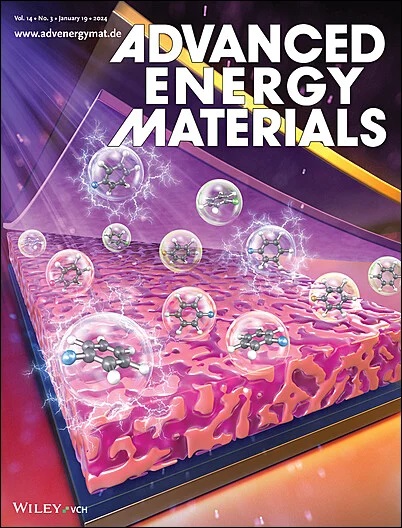Atomic Layer Deposition-Modified Bifunctional Electrocatalysts for Rechargeable Zinc-Air Batteries: Boosting Activity and Cycle Life
IF 26
1区 材料科学
Q1 CHEMISTRY, PHYSICAL
引用次数: 0
Abstract
The integration of transition metal-carbon composites has shown remarkable potential in achieving superior bifunctional electrocatalytic activity and robust stability in rechargeable zinc-air batteries (ZABs), primarily through electronic structure modulation and strategic structural design. While significant research is dedicated to the initial structure and performance of bifunctional electrocatalysts for rechargeable ZABs, their dynamic evolution during charge–discharge cycling remains underexplored. In this study, CoFe nanoparticles are encapsulated within carbon nanotubes co-doped with nitrogen and phosphorus (NPC) to mitigate dissolution and erosion risks. Further, the catalyst surface (CoFe-NPC) is precisely modified with a thin layer of nickel oxide (NiO) via atomic layer deposition (ALD), forming a protective layer with catalytic activity. The resulting ALD-modified catalyst, CoFe-NPC@NiO, exhibits outstanding bifunctional performance (ΔE = 0.592 V) for the oxygen reduction reaction (ORR) and oxygen evolution reaction (OER). Notably, the liquid flow ZAB using the CoFe-NPC@NiO cathode demonstrates exceptional rechargeable stability (2700 h, ≈4 months). Theoretical calculations and in situ X-ray absorption spectroscopy (XAS) analyses reveal that NiO modification significantly enhances both the catalytic activity and stability of the electrocatalyst. This work will provide valuable insights into the design of advanced electrocatalysts, facilitating advancements in activity enhancement, stability improvement, and selectivity optimization.

可充电锌-空气电池的原子层沉积改性双功能电催化剂:提高活性和循环寿命
过渡金属-碳复合材料的集成在可充电锌空气电池(ZABs)中显示出卓越的双功能电催化活性和强大的稳定性,主要通过电子结构调制和战略性结构设计。虽然对可充电ZABs双功能电催化剂的初始结构和性能进行了大量的研究,但对其在充放电循环过程中的动态演变仍未深入研究。在这项研究中,CoFe纳米颗粒被包裹在共掺杂氮磷(NPC)的碳纳米管中,以减轻溶解和侵蚀风险。进一步,通过原子层沉积(ALD)在催化剂表面(fe - npc)上精确修饰一层薄薄的氧化镍(NiO),形成具有催化活性的保护层。得到的ald改性催化剂CoFe-NPC@NiO在氧还原反应(ORR)和氧析出反应(OER)中表现出优异的双功能(ΔE = 0.592 V)。值得注意的是,使用CoFe-NPC@NiO阴极的液体流动ZAB表现出优异的可充电稳定性(2700小时,≈4个月)。理论计算和原位x射线吸收光谱(XAS)分析表明,NiO改性显著提高了电催化剂的催化活性和稳定性。这项工作将为高级电催化剂的设计提供有价值的见解,促进活性增强,稳定性改善和选择性优化的进展。
本文章由计算机程序翻译,如有差异,请以英文原文为准。
求助全文
约1分钟内获得全文
求助全文
来源期刊

Advanced Energy Materials
CHEMISTRY, PHYSICAL-ENERGY & FUELS
CiteScore
41.90
自引率
4.00%
发文量
889
审稿时长
1.4 months
期刊介绍:
Established in 2011, Advanced Energy Materials is an international, interdisciplinary, English-language journal that focuses on materials used in energy harvesting, conversion, and storage. It is regarded as a top-quality journal alongside Advanced Materials, Advanced Functional Materials, and Small.
With a 2022 Impact Factor of 27.8, Advanced Energy Materials is considered a prime source for the best energy-related research. The journal covers a wide range of topics in energy-related research, including organic and inorganic photovoltaics, batteries and supercapacitors, fuel cells, hydrogen generation and storage, thermoelectrics, water splitting and photocatalysis, solar fuels and thermosolar power, magnetocalorics, and piezoelectronics.
The readership of Advanced Energy Materials includes materials scientists, chemists, physicists, and engineers in both academia and industry. The journal is indexed in various databases and collections, such as Advanced Technologies & Aerospace Database, FIZ Karlsruhe, INSPEC (IET), Science Citation Index Expanded, Technology Collection, and Web of Science, among others.
 求助内容:
求助内容: 应助结果提醒方式:
应助结果提醒方式:


